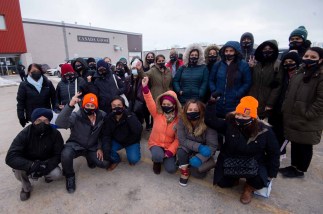Troubling prognosis for health-care staffing in south Fed-up physicians looking for an exit in region with worst vaccination rates in province
Read this article for free:
or
Already have an account? Log in here »
To continue reading, please subscribe:
Monthly Digital Subscription
$0 for the first 4 weeks*
- Enjoy unlimited reading on winnipegfreepress.com
- Read the E-Edition, our digital replica newspaper
- Access News Break, our award-winning app
- Play interactive puzzles
*No charge for 4 weeks then price increases to the regular rate of $19.00 plus GST every four weeks. Offer available to new and qualified returning subscribers only. Cancel any time.
Monthly Digital Subscription
$4.75/week*
- Enjoy unlimited reading on winnipegfreepress.com
- Read the E-Edition, our digital replica newspaper
- Access News Break, our award-winning app
- Play interactive puzzles
*Billed as $19 plus GST every four weeks. Cancel any time.
To continue reading, please subscribe:
Add Free Press access to your Brandon Sun subscription for only an additional
$1 for the first 4 weeks*
*Your next subscription payment will increase by $1.00 and you will be charged $16.99 plus GST for four weeks. After four weeks, your payment will increase to $23.99 plus GST every four weeks.
Read unlimited articles for free today:
or
Already have an account? Log in here »
Hey there, time traveller!
This article was published 02/12/2021 (1429 days ago), so information in it may no longer be current.
Some physicians who’ve been subjected to physical threats and verbal abuse because of COVID-19 are thinking about leaving southern Manitoba, where there aren’t enough doctors and nurses now.
“There has been a lot of disillusionment amongst especially younger physicians in our hospital,” said Dr. Ganesan Abbu, an anesthetist and special care unit doctor at Boundary Trails Health Centre, which is located between Winkler and Morden.
“I think they’ve sustained a lot of abuse. We’ve had nasty letters being sent — in some cases, even delivered to physicians’ doorsteps, Facebook posts, that kind of thing.”
One of Abbu’s colleagues has decided to leave and at least two others are considering a move.
“I think those of us that have been here a long time, even if we’re not from the local community, there’s a greater degree of tolerance, we kind of understand the mentality and the ideology of some of this community a little better,” said the area resident of more than two decades.
Nevertheless, the situation is taking a toll, both on older practitioners getting close to retirement age, and younger professionals who’ve simply had enough.
“I think in terms of human resources, there are going to be huge issues in the next couple of years,” Abbu said.
Most people working in the health-care sector have, from time to time, had to deal with aggressive patients or family members in stressful circumstances, but because there have been so many confrontational incidents across the profession during the pandemic, Doctors Manitoba felt it necessary to distribute a guide to physician safety.
Preliminary data from a recent survey collected by the professional advocacy organization shows that half of doctors surveyed had experienced at least one incident of verbal abuse, threats, harassment or physical assault over the past month, and half of those incidents had some relation to COVID-19.
“We have been seeing a trend to more of these incidents happening during the pandemic,” president Dr. Kristjan Thompson said. “I think people are stressed. I think they’re scared, they’re frustrated. And unfortunately, they’re channeling this anger and frustration against the very people that are there to help.”

Thompson said survey revealed that physicians across the province are experiencing these sorts of incidents, but they’re more prevalent in rural areas.
“There really is no excuse — physicians shouldn’t face any violence, attacks or threats,” he said.
Doctors Manitoba has more than 4,000 members, and the data collected will be part of a larger report to come that Thompson said will help the organization support doctors experiencing mistreatment at work.
Making matters worse, Manitoba’s ongoing shortage of emergency and critical-care nurses has left approximately one in four positions vacant in the Southern Health region, where Boundary Trails is located. And the region’s hospitals and medical clinics don’t have an adequate number of physicians, said its chief medical officer, Dr. Denis Fortier.
Southern Health has, for some time, been the fastest-growing health region in the province; its population increases by about 3,000-4,000 people every year, which requires the addition of five or six physicians for an adequate doctor-patient ratio.
The deficit was a problem before the pandemic and it’s worse now, Fortier said, adding doctors are reporting higher stress levels as a result of unpleasant conversations with patients about health orders and vaccinations.
“COVID is certainly causing challenges,” he said. “The way that the health-care profession — not just physicians — was applauded and cheered early on in the pandemic and is now jeered by many is disheartening for our staff, who are already tired.”
There’s a risk that some primary-care services in the region could be reduced or disappear entirely if more doctors pack up, he said. Two-week waits for an appointment with a family doctor could be stretched to six weeks or beyond. And the impacts could affect emergency services and surgery wait lists.
“We’re seeing some of that already, as it relates to the pressure of COVID,” he said. “But this is what we would see, we would have to evaluate services.”
malak.abas@freepress.mb.ca

Malak Abas is a city reporter at the Free Press. Born and raised in Winnipeg’s North End, she led the campus paper at the University of Manitoba before joining the Free Press in 2020. Read more about Malak.
Every piece of reporting Malak produces is reviewed by an editing team before it is posted online or published in print — part of the Free Press‘s tradition, since 1872, of producing reliable independent journalism. Read more about Free Press’s history and mandate, and learn how our newsroom operates.
Our newsroom depends on a growing audience of readers to power our journalism. If you are not a paid reader, please consider becoming a subscriber.
Our newsroom depends on its audience of readers to power our journalism. Thank you for your support.






